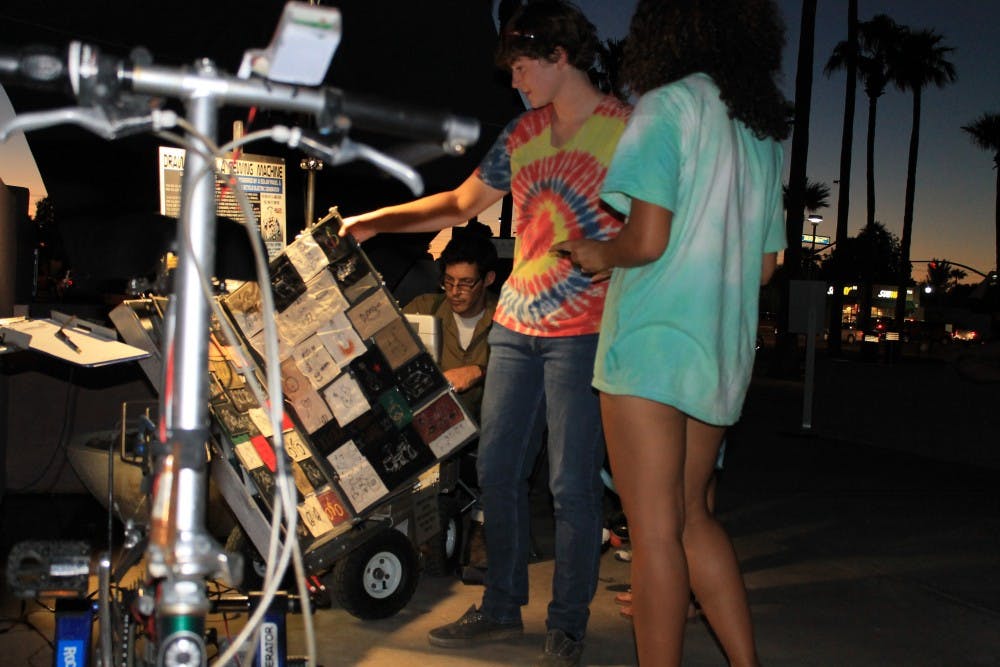 ASU Art Museum visitors sift through Paul Nosa's collection of sewed works as he works on a personalized patch. The bicycle shown is used to generate power for his Singer sewing machine. (Photo by Kylie Gumpert)
ASU Art Museum visitors sift through Paul Nosa's collection of sewed works as he works on a personalized patch. The bicycle shown is used to generate power for his Singer sewing machine. (Photo by Kylie Gumpert)The ASU Art Museum held its opening for the fall season this evening that introduced three different exhibitions, brought out an assortment of showcased artists and included an interesting and sustainable sewing performance by Paul Nosa.
Nosa’s workstation, including a Singer CG-590 sewing machine, a bicycle mechanically fixed to produce an hour of sewing time from ten minutes spent pedaling, a 50-watt solar panel and a collection of his patch work for the crowd to sift through, was set up outside of the museum. His performance, co-sponsored by the Global Institute of Sustainability, included creating one-of-a-kind patches for passerby who could come up with an idea in five words or less.
The Tucson-native, who has been touring the country on a sewing venture, is now sewing larger, fine art pieces and believes that all of life’s questions can be answered with a sewing machine.
“Since I started sewing it seems that everything I ever needed or wanted has come my way,” Nosa said. “Whether it be that it makes money, or that I can fix my clothes or that I meet the right people, or I go to the right places, the sewing machine has been the way to get there.”
Inside, the evening’s exhibits included “Crafting a Continuum: Rethinking Contemporary Craft,” which highlights craft innovation and experimentation, “Wendy Maruyama: Executive Order 9066,” which tells the story of Japanese-American internment camps created from President Franklin D. Roosevelt’s Executive Order 9066, and “This Is Not America: Protest, Resistance and Poetics,” which is meant to create conversation on current issues and resistance.
Deborah Sussman-Susser, PR specialist for the Nelson Fine Arts Centers, said that two of the featured artists actually created their pieces within the museum walls.
“To have Christine Lee and Del Harrow working in the museum so that people can see, that’s what we really strive to do, is open the process,” Sussman-Susser said. “So, you don’t just see the art, you see the artist. “
Christine Lee’s “Shims: Thousands of Uses-Use #28” is an expansive wall-piece created from shims, paint and graphite that is meant to stimulate further thought and conversation on issues of sustainability. Lee spent just less than a week putting it together in-house, and balancing each shim with out any sort of glue.
For Lee, the opening was a great night to come back to what she calls a welcoming place.
“I feel very welcome here and have just reconnected with everybody again,” Lee said.
Lee was a visiting artist last year and taught a class in the art department’s wood program. She said that some of students came by to support her, and that the response so far had been wonderful.
The artist will be coming back to AZ in November to present a collaboration introducing a new material that is non-toxic.
Wendy Maruyama’s exhibit featured numerous, floor-to-ceiling collections made of thousands of re-created internment camp tags. As a third generation Japanese-American, Maruyama was affected by the history.
“She told me that in making those tags that it turned into a big community project just by itself,” Sussman-Susser said. “She ultimately had people who had been interned in camps working alongside young Japanese-Americans, making tags, but sharing their experiences.”
Sussman-Susser said that this opening is important for the museum because it gives the community a chance to come together and see the shows. While having people come out for the big opening party, she said that the museum would love to have people come back when it’s quiet, to “really see the work.”
In regards to the amount of students coming out the museum, Sussman-Susser said that she is surprised by how many have not actually been to the building.
“We are a little bit of a hidden treasure, and we would like to be less hidden,” Sussman-Susser said. “Especially as far as the students go, because their involvement is critical.”
“Crafting a Continuum: Rethinking Contemporary Craft” will run until Dec. 7, “Wendy Maruyama: Executive Order 9066” will run until Jan. 4 2014 and “This Is Not America: Resistance, Protest and Poetics” runs until June 6, 2014.
Reach the reporter at kgumpert@asu.edu or follow her on Twitter @cat2bekittenmee




